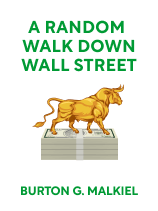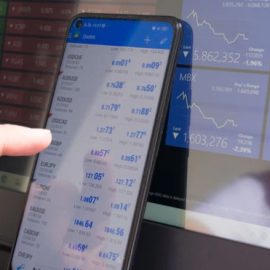

This article is an excerpt from the Shortform book guide to "A Random Walk Down Wall Street" by Burton G. Malkiel. Shortform has the world's best summaries and analyses of books you should be reading.
Like this article? Sign up for a free trial here .
Are you looking for the best examples of economic bubbles in history? What can you learn from these examples?
From tulipmania in 17th Century Holland to the recent speculation around bitcoin, economic bubbles can be seen throughout history. Caused by public speculation and irrational optimism, economic bubbles are an inevitable consequence of the stock market.
Keep reading for a complete list of economic bubbles in history.
A List of Economic Bubbles In History
The following list of economic bubbles in history will help you to understand how bubbles form and why they inevitably burst.
Early Bubbles
The earliest examples of economic bubbles in history show that this is not a modern phenomenon:
Tulip Mania
Arguably the most famous—or infamous—economic bubble in history, the tulip mania that struck 17th-century Holland perfectly illustrates the dangers of castle-in-the-air investing.
The craze centered on specific bulbs, called “bizarres” by the Dutch, that were infected with a nonfatal virus that caused the petals to develop vivid colors and patterns. The demand for these striking flowers caused tulip merchants to buy bulbs in bulk, which resulted in a rise in prices and attracted value investors as well as speculators. The craze became self-perpetuating: Prices continued to rise due to ever greater investment, which led to even higher prices and then even more investment. In 1634–1637, the years just before the crash, people began bartering valuables like jewelry and land to buy tulip bulbs.
Although some economic historians, including Peter Garber, have attempted to argue that prices during the craze were rational, few can justify the 20x increase in tulip-bulb prices that occurred in January 1637—or the equivalent crash in prices the very next month.
South Sea Bubble
During this famous stock market bubble, a trading firm called the South Sea Company rose in value by nearly 700% in a matter of months and fell by the same amount shortly thereafter. This happened in 18th Century England, making it one of the earliest known speculative bubbles in history.
The Great Crash of 1929
Speculative crazes like the tulipmania in Holland and the South Sea Bubble in 18th-century England—during which—aren’t just a thing of the distant past.
The stock market crash of 1929, which precipitated the Great Depression, is another example of irresponsible castle-in-the-air thinking.
Wide prosperity in the U.S. had boosted the stock market, and increased optimism among investors, and investing on margin—that is, borrowing to speculate in the stock market—had become commonplace. Traders were also engaging in some unsavory practices, like forming investment pools, to manipulate stock prices. (An investment pool consisted of a group of traders who would collude to bid up a stock price and then sell once those outside the pool began buying the stock.)
The higher prices were completely driven by irrational confidence that stocks would continue to rise in value.
On September 3, 1929, despite a recent downturn in business activity, the stock market reached an all-time high, one that wouldn’t be reached for another 25 years. Two days later there was a sharp decline, followed by months of uncertainty. In late October, brokers began making margin calls, many of which went unmet due to insolvent borrowers. On October 29, the market collapsed, with some major firms like GE and Bethlehem Steel losing 95% or more of their value.
Financial Fads of the Postwar Era
Examples abound of financial institutions’ tendency to indulge in irrational optimism. Here are a few of the famous crazes of the last 60 years.
1960s: The “Tronics” Boom
In the early years of the decade, companies with “electronics” or related words in their names, regardless of their actual product or profitability, enjoyed large price-earnings multiples that were quickly shown to be inflated. Many of these companies—Boonton Electronic Corp., Hydrospace Technology—which traded at high prices in the early 1960s, no longer exist.
1960s: The Conglomerate Boom
Firms were able to impart the perception of growth by absorbing companies of equal or lesser value, often in wildly different industries from themselves. The crux of this boom was, again, the price-earnings multiplier: As a conglomerate absorbed more companies, thereby raising earnings, its multiplier would grow as well—but the multiplier would often outpace the actual earnings. When the conglomerates’ earnings came in far lower than the multiplier’s calculation, prices tumbled.
1960s: The Rise of “Concept” Stocks
In the later years of the decade, risk-taking fund managers banked on so-called “concept” stocks—shares in firms with a dynamic leader or good “story.” Of course, in many cases, the stories were too good to be true—the firms had no revenue-generating potential, and the stock prices were revealed to be absurdly inflated.
1970s: The Turn to Blue-Chip Companies
After the boom and bust of conglomerates and concept stocks in the ’60s, finance professionals placed their bets on so-called “blue-chip” companies: Firms with household names, like IBM, Disney, and McDonalds, whose growth potential was taken for granted. Fund managers began speculating on these companies, however, raising price-earnings multiples to 80 or 90—a near impossible ask for a large-capitalization company. (Large capitalization companies with high dividends can’t grow fast enough to justify the huge premiums on their prices.) Between 1972 and 1980, the price-earnings multiple for McDonald’s went from 83 to 9; for Polaroid, 90 to 16.
1980s: The Siren Song of New Issues: ZZZZ Best
As with the early 1960s, the early 1980s saw professional investors flocking to flashy new issues, in this case primarily companies in the biotechnology and microelectronics fields.
One overvaluation that exemplified the era concerned a carpet-cleaning company called ZZZZ Best. Founded by an entrepreneur named Barry Minkow when he was just 15, ZZZZ Best found considerable success in just a few years, turning Minkow into a millionaire by the time he was 18.
However, it was Minkow’s flair for self-promotion—he drove a Ferrari and had an enormous Z painted on the bottom of his home’s swimming pool—that drew investors to the company. At the height of the company’s rise, its price-earnings multiplier was 100. Unfortunately for these investors, what earnings ZZZZ Best did report were due to a money laundering deal Minkow had struck with the mob. Minkow ended up doing time in a federal prison, and the company folded.
21st-Century Booms and Busts
One might imagine that with 300 years’ worth of economic experience, during which societies suffered steep recessions and depressions due to speculative bubbles, humanity would have improved its mechanisms for recognizing and mitigating those bubbles. Not so. In fact, the crashes of the early 2000s—the internet bubble at the beginning of the century and the real-estate bubble 10 years later—illustrate that castle-in-the-air thinking is just as prevalent today as it was in 18th-century Holland.
The investing principle we should take away from any bubble, the internet and housing bubbles not least among them, is this: There is no “sure thing” or “get rich quick” in the market. Invest in industries that have profit-making and profit-sustaining potential, rather than industries that purport to transform society. Avoid getting caught up in the hype of a new sector or technology; stay calm and keep your portfolio as broadly diverse as possible.
Our list of economic bubbles in history takes a look at two of the best examples from the 21st-Century:
The Dot-Com Bubble
In the financial world, the early 2000s were marked by the rise of Internet stocks. Even though many of these “dot-com” companies had zero earnings (and zero potential for realizing earnings), they were valued astronomically highly.
In January of 2000, the price-earnings multiples of stocks in the NASDAQ Index—the index of technology and Internet stocks—were over 100, and investors expected returns of between 15 and 25 percent on Internet stocks. When the bubble burst later in the year, many Internet stocks became worthless, and blue-chip Internet stocks like Cisco and Amazon lost 86.5% and 98.7% of their value.
The Housing Bubble
The 2008 financial crisis was, by and large, the handiwork of finance professionals.
when large numbers of mortgage holders began defaulting on their loans and the swaps were triggered, the sellers of the swaps were saddled with huge payment obligations—obligations they simply couldn’t meet.
The fallout was extraordinary, with some of the most storied and successful financial institutions of the 20th century—Bear Stearns, Merrill Lynch, Lehman Brothers, AIG—suffering staggering losses. Some of these firms, like Lehman, declared bankruptcy; others, like Merrill, merged with more stable institutions; still others, like AIG, had to be rescued by the US government.
A Postmodern Bubble: Cryptocurrencies
Our list of economic bubbles in history doesn’t end with the end of the 20th Century.
Although considerably less far-reaching in their implications—because the markets are comparatively small—bubbles in cryptocurrencies like bitcoin are the latest iteration of castle-in-the-air enthusiasm. Malkiel’s advice is to stay away.
Bitcoin
Created in 2008–2009 by an anonymous inventor (or group of inventors) who goes by the name Satoshi Nakamoto, bitcoin is an exclusively digital peer-to-peer currency. Bitcoin “tokens” are tracked and exchanged via an encrypted and anonymous public ledger called a blockchain. The blockchain records the ownership and transference of each of the 21 million tokens currently in circulation. Bitcoin evangelists see the currency in utopian terms—as a global and fraud-proof form of money.
In the years since its creation, the value of bitcoin has fluctuated wildly. For example, in 2010, a bitcoin token could be purchased for less than a penny. By December 2017, the value of a single bitcoin was fluctuating between $14,000 and $20,000!
For some, these fluctuations have been lucrative: Early investors—like the Winklevoss twins, who famously sued Mark Zuckerberg for stealing their idea for Facebook—have become bitcoin billionaires. For others, they’ve been torturous: Values of individual tokens have occasionally fallen by 50% in a matter of days.
But is bitcoin a bubble? Malkiel says yes. The rapid rise in the price of a bitcoin is one indication; the proliferation of competing cryptocurrencies—with some, like dogecoin, acknowledging their own absurdity—is another. Bitcoin, due to its anonymity and ease, is also the currency of choice for various illegal transactions, from drugs to assassinations, and it’s more than likely that governments will eventually crack down on its use.
The above list of economic bubbles in history will help you to better understand how economic bubbles and how they work.

———End of Preview———
Like what you just read? Read the rest of the world's best book summary and analysis of Burton G. Malkiel's "A Random Walk Down Wall Street" at Shortform .
Here's what you'll find in our full A Random Walk Down Wall Street summary :
- A comprehensive and entertaining introduction to the world of finance
- Practical investment principles that work for every skill level
- The advantages of index investing






